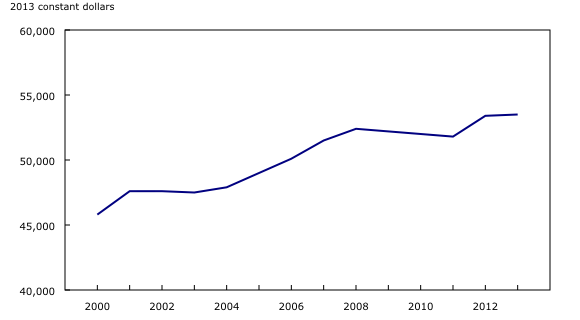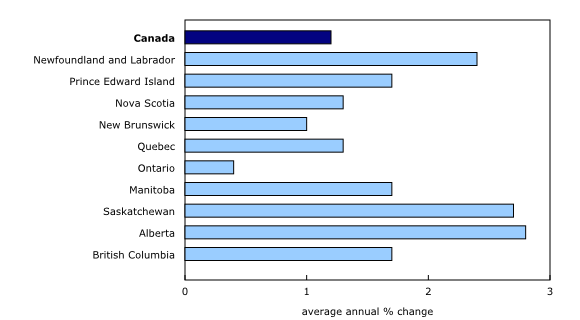Income of Canadians, 2000 to 2013
Archived Content
Information identified as archived is provided for reference, research or recordkeeping purposes. It is not subject to the Government of Canada Web Standards and has not been altered or updated since it was archived. Please "contact us" to request a format other than those available.
Released: 2015-12-17
Alberta, Saskatchewan and Newfoundland and Labrador, all resource-rich provinces, saw their median family after-tax incomes grow the most from 2000 to 2013. Ontario was the lone province to experience median family income growth substantially lower than the national average.
During the post-2000 period, median after-tax incomes rose for economic families and persons not in an economic family, with the growth being shared by those with lower and higher incomes.
Income growth across the income distribution
The median after-tax income of Canadian economic families and persons not in an economic family increased 16.8%, from $45,800 in 2000 to $53,500 in 2013. This equates to an average growth rate of 1.2% per year. However, this growth rate was not consistent. It ranged from a high of 3.9% during the start of the century to several periods of no annual change during downturns, such as the 2008 and 2009 recession.
In addition to looking at the median—the mid-point of the income distribution—economic families and persons not in an economic family can be divided into 10 equal-sized groups, or deciles, from lowest to highest after-tax income. This provides an overview of the distribution of after-tax income in Canada. When measured this way, income grew in all deciles.
For example, in 2000, economic families and persons not in an economic family with an after-tax income below $15,100 made up the lowest decile. By 2013, this limit had increased by 14.6% to $17,300. The upper limit of the ninth decile moved from $104,800 in 2000 to $130,600 in 2013, an increase of 24.6%. Economic families and persons not in an economic family with after-tax income greater than this value would be in the top 10%. When viewed as an annual average rate of change, the upper limit of the lowest decile increased by 1.1% per year, while the upper limit of the ninth decile increased by 1.7% per year.
Income inequality
For statistics on income inequality, it is common practice to use income measures based upon after-tax household income that has been adjusted for household size (adjusted after-tax income). Adjusting after-tax income for household size allows users to compare the income of households of different sizes.
One way to look at income inequality is to look at the share of income held by various segments of the income distribution. Based on adjusted after-tax income, Canadians in the highest decile accounted for 23.7% of total after-tax income in Canada in 2013, virtually unchanged from 2000, while Canadians in the lowest decile represented 2.5%, unchanged from 2000.
Incidence of low income
The after-tax low income measure (LIM-AT) is an internationally used measure of low income. The concept underlying the LIM-AT is that all persons in a household have low income if their household income is less than half of the median income of all households. According to the LIM-AT, 4.6 million people, or 13.5% of the population, lived in low income in 2013. The rate has been fairly stable since the early 2000s, which reflects the fact that, while income grew for lower-income persons, it grew at about the same pace as median income.
Trends by province
While nationally, median after-tax income of Canadian economic families and persons not in an economic family grew at a rate of 1.2% per year from 2000 to 2013, the growth rate was not consistent across the country. The median grew by more than 2% per year in three provinces, Alberta (+2.8%), Saskatchewan (+2.7%) and Newfoundland and Labrador (+2.4%). Ontario was the lone province whose median growth was substantially lower than the national average (+0.4%).
Note to readers
In this release, data for 2000 to 2011 are from the Survey of Labour and Income Dynamics (SLID) and data for 2012 and 2013 are from the Canadian Income Survey (CIS).
Data from the SLID were revised for the years 2006 to 2011 to allow CIS data to be compared with data for earlier years. No revisions were made to data prior to 2006.
In the implementation of the revision for 2006 to 2011, revisions to the data were made in such a way as to minimize "breaks" in trends. Nonetheless, for some characteristics the data trends could reveal a "break" because of the change in methodology. Such a break would appear as a noticeable upward or downward shift in the data. These breaks may be found in estimates for 2006 and 2012 and may be more prevalent in estimates for small domains such as family type or region.
For more information on this revision, see the report "Revisions to 2006 to 2011 income data."
This release examines the income of economic families and persons not in an economic family, as well as low income in Canada.
An economic family refers to a group of two or more persons who live in the same dwelling and are related to each other by blood, marriage, common-law, adoption or a foster relationship.
This release, for the most part, analyzes income on the basis of medians. The median is the level of income at which half the population has higher income and half has lower. Likewise, the upper limit of the lowest decile is the level of income at which 90% of the population has higher income and 10% has lower. The upper limit of the ninth decile is the level of income at which 10% of the population has higher income and 90% has lower.
Income estimates are expressed in 2013 constant dollars to factor in inflation and enable comparisons across time in real terms.
After-tax income is the total of market income and government transfers, less income tax.
Market income consists of earnings, private pensions as well as income from investments and other sources such as support and disability payments.
Government transfers include benefits such as Old Age Security, Guaranteed Income Supplement, Canada and Quebec Pension Plan, Employment Insurance, Social Assistance, Goods and Services Tax Credit, provincial tax credits and various types of child benefits.
Income inequality refers to the extent that income is distributed unequally among members of a population. This analysis reports on income inequality using statistics based on adjusted after-tax income. This adjustment distributes income among the members of the household, and takes into account the economies of scale present in larger households, the increasing number of people living on their own and the decline in family size over time. The adjustment is made by dividing household income by the square root of the household size and assigning this value to all persons in the household. While there are different ways to describe income inequality, this analysis reports on the share of adjusted after-tax income held by various segments of the income distribution.
Low income in this release is calculated using the after-tax low income measure (LIM-AT). Individuals are defined as having low income if their adjusted after-tax income falls below 50% of the median adjusted after-tax income. Adjusted after-tax income is derived by dividing household income by the square root of the household size and assigning this value to all persons in the household. LIM-AT thresholds are computed each year and vary according to trends in median income. Because the LIM-AT threshold is defined relative to the median income, the LIM-AT reflects how families at the lower end of the income distribution are faring relative to the typical Canadian family. In 2013, the LIM-AT threshold for a family of four was $41,866.
Other low income lines (Low Income Cut-offs and Employment and Social Development Canada's Market Basket Measure) are available in CANSIM tables 206-0092 and 206-0093 and in the article "Low Income Lines, 2013-2014: Update" as part of the Income Research Paper Series (75F0002M). Low income statistics based on each measure are available in CANSIM tables 206-0041 and 206-0042.
Products
The article "Revisions to 2006 to 2011 income data," which is part of the Income Research Paper Series (75F0002M), is now available from the Browse by key resource module of our website under Publications.
The article "Low Income Lines, 2013-2014: Update," which is part of the Income Research Paper Series (75F0002M), is now available from the Browse by key resource module of our website under Publications.
Custom tabulations are available upon request.
Contact information
For more information, or to enquire about the concepts, methods or data quality of this release, contact us (toll-free 1-800-263-1136; 514-283-8300; STATCAN.infostats-infostats.STATCAN@canada.ca) or Media Relations (613-951-4636; STATCAN.mediahotline-ligneinfomedias.STATCAN@canada.ca).
- Date modified:





